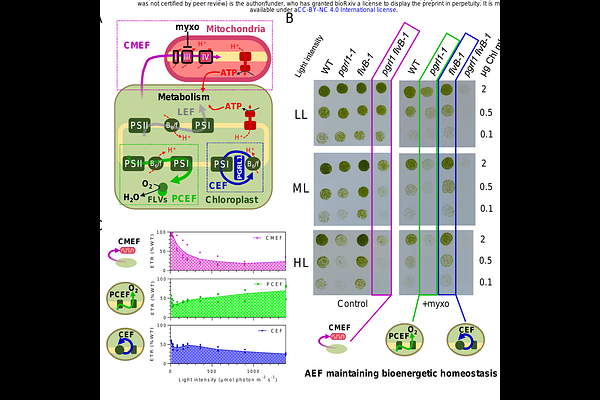Sustaining the cell energy in dynamic environments requires photosynthetic electron flows with diverse bandwidths

Sustaining the cell energy in dynamic environments requires photosynthetic electron flows with diverse bandwidths
Madireddi, S. K.; Adler, L.; Stoffel, C.; Schroeder, M.; Tolleter, D.; Burlacot, A.
AbstractAll living cells depend on the dynamic balance between their energy supply and demand to survive and thrive in dynamic environments. In extreme cases, like for photosynthetic organisms, their energy source, light, can fluctuate dramatically in intensity over timescales of seconds to hours. While various photosynthetic electron flows (EF) are crucial for maintaining bioenergetic homeostasis, how EFs are modulated to respond to dynamic energy intake remains unclear. Here, we show in the model green alga Chlamydomonas reinhardtii that each EF is best suited to a specific domain of energetic fluctuation periodicity for which it can support the cells energetic needs, which we term bandwidth. By systematically exposing cells to a range of light periodicities, we show that while cyclic EF has a large bandwidth, pseudo-cyclic EF (PCEF) can only sustain the cells energetic needs for fast light fluctuations, and that the interplay between the chloroplast and the mitochondria (CMEF) has a limited bandwidth. We further show that the bandwidths of PCEF and CMEF, specialized for dynamic lights, are related to their capacity to generate ATP and protect the photosynthetic apparatus. Finally, we show that in wild-type cells, the activity level of PCEF and CMEF matches their bandwidth, and we propose that cells tune the relative activity of each AEF depending on the light fluctuation frequency. Our work opens an avenue of research to characterize the molecular mechanisms required for phototrophic growth in complex and dynamic energetic landscapes. It further provides a generalizable framework for understanding the physiological importance of molecular mechanisms in a dynamic environment.